by Editor | Jul 21, 2014 | Attractions, Ecotourism
Article and photos by Elena del Valle
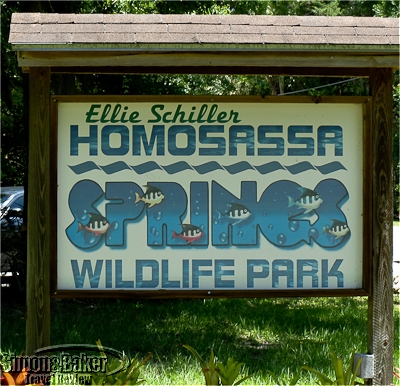
Homosassa Springs Wildlife Park
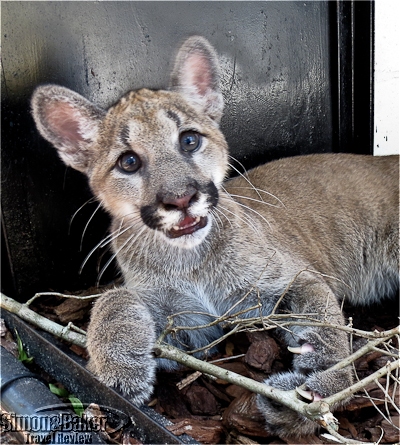
Yuma, the Florida panther cub (click to enlarge)
Florida’s state animal, the panther, is one the most endangered mammals on Earth. With population estimates at less than 200 they are near impossible to observe in the wild. According to the U.S. Fish and Wildlife Service, there are between 100 and 160 adult panthers in the wild in South Florida. These animals once ranged throughout most of the southeastern United States. By the late 1800s the Florida panther had been run off from much of its historical range because its habitat had been destroyed or by human attacks.
They are beautiful animals. When I found out I might be able to see a four month old cub in a wildlife sanctuary I jumped at the opportunity. The drive, several hours long, took me across the state from the southeastern corner of the Florida peninsula northwest to the Ellie Schiller Homosassa Springs Wildlife State Park (4150 S. Suncoast Boulevard, Homosassa, Florida 34446, www.floridastateparks.org/homosassa, +1 352 628-5343, Susan.Strawbridge@dep.state.fl.us) in Citrus County where the cub found a permanent home. I stayed at the 68-room Hampton Inn Crystal River (1103 N Suncoast Boulevard, Crystal River Florida, 34429, +1 352-564-6464, www.crystalriver.hamptoninn.com, Chris@mymaverick.net) a clean, newly built (completed in 2013) property conveniently situated a few miles north of the park.
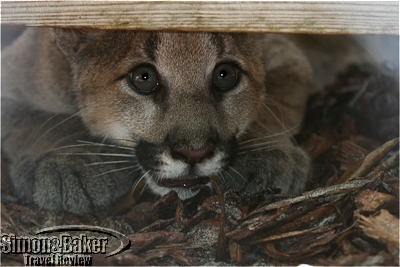
The cub was playful and in constant motion
When he was one week old he was rescued by wildlife personnel after his mother abandoned him or met an unknown fate herself. Having been brought up by humans, he would not be able to survive in the wild. Instead, his home will be a 80 foot by 120 foot special enclosure at the state park which was still under construction when I visited the area.
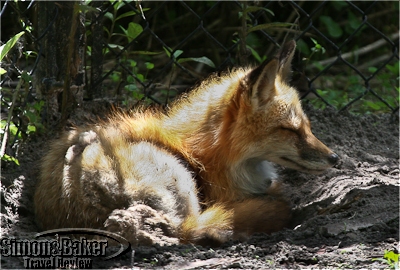
This cute red fox was sleeping in the partial shade
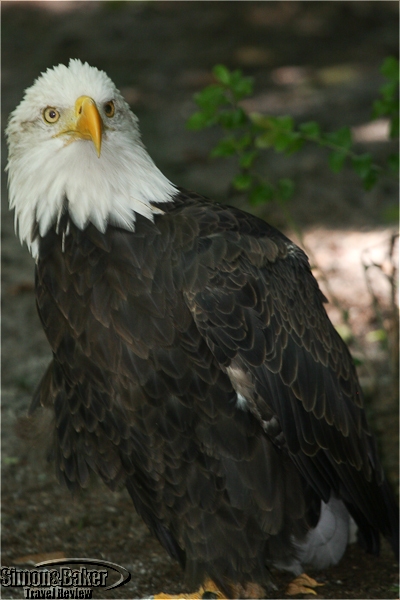
One of several eagle residents
Yuma, meaning son of the chief in a blend of Native American languages, was playful, energetic and mesmerizing. I could have watched him all day, racing across one side of his temporary fenced in enclosure to the other, climbing, chewing on his toys, eating, leaping against the fence or sitting in the shade.

A pink flamingo
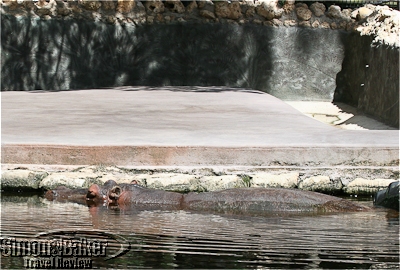
In typical hippo fashion, Lu spends his day submerged and barely visible
With 300,000 annual visitors, the 210 acre Ellie Schiller Homosassa Springs Wildlife State Park is said to be the most visited state park in Florida. At the time I was there, it was home to fifty Florida animals such as black bears, bobcats, river otters, red wolves, Key deer, American alligators, gray fox, red fox, roseate spoonbills, eagles, herons, egrets and whooping cranes. There were several resident West Indian manatees which could at times be seen from a floating observatory that sits in the middle of Homosassa Springs. Perhaps the most famous resident of the park was Lu, a hippopotamus who was made a Florida citizen by a governor’s decree so that he could live out his days in the park when it was converted to an exclusive home of native wildlife.
by Editor | Jul 7, 2014 | Accomodations, Ecotourism, New Articles
Article and photos by Josette King
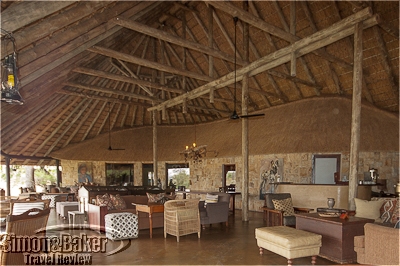
The lounge was an eclectic mix of safari antiques, rustic furniture, local crafts
On my first visit to Southern Africa a decade or so ago, my very first guide predicted: “Once the red dirt of Africa gets into you hiking boots, you will never get it out.” Now, a couple of pairs of boots later, I understand what he meant. But, the power of iron saturated clay dust notwithstanding, what keeps me going back is that every so often on those safaris, I come across an exceptional guide who can make the wonder of the natural world come alive, someone like Hearold Mgiba, the guide I had the good fortune to meet on my recent visit to Motswari Private Game Reserve in South Africa.
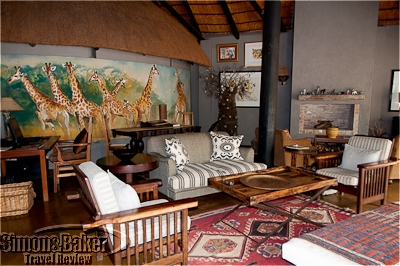
The library and art gallery
Wedged in the northern corner of the famed 54,000 hectare (209 square mile) Timbavati Nature Reserve, one of the oldest and most pristine in South Africa, and with an open boundary with Kruger National Park, Motswari is reputed for its density of game. The Big Five (buffalo, elephant, leopard, lion and rhino) roam there. So I expect it would have been relatively easy for Hearold and Difference Hlophe, an excellent tracker, to ensure that I enjoyed what is considered the gold standard of African safaris: repeated Big Five sightings. And I did enjoy those, daily. But one hour into our first drive, I was beyond counting. We were driving into thicket so dense I didn’t imagine we could possibly get through it, much less see anything of note, tracking a leopard. Hearold and Difference knew their big cats and found the one they were searching for in the end, concealed in the rocks near a water hole. We followed it around its territory to the tree where it had stashed its recent impala kill.
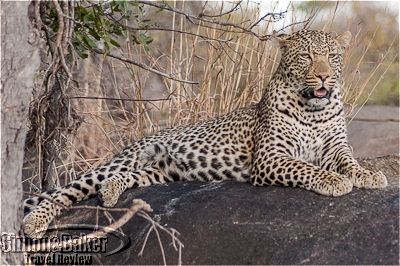
A large male leopard surveys its domain
The next morning found us among leopards again as we watched an old male go in the blink of an eye from snoozing in the high grass to snarling menacingly from the top of a 20 meter (65 foot) tree at his nonplussed pursuer. In fact, in my three days at Motswari, I was able to observe at length and at close range more leopards than I had seen in all of my previous visits to Africa. And there were also lions: a fascinating interaction between two males feeding on the carcass of a buffalo calf, and a whole pride going about its daily business; and elephants, a large breeding herd of them on the move with nursing calves; and mud encrusted rhinos crashing their way out of a water hole; and cheetahs on the prowl, and a whole supporting cast of mammals and birds. And in most instances, these weren’t mere sightings but unique opportunities to enjoy an authentic bush experience.
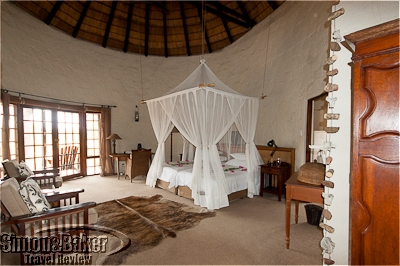
My Bungalow was decorated in relaxing neutral tones
The lodge itself reinforced this feeling. With its neat guest room rondavels scattered in a mature grove along the river, the homey atmosphere of its public areas and its large boma for dinners around the flames of a central fire pit, Motswari had the feel of a family country estate. I especially enjoyed the relaxed simplicity of my airy rondavel, with the creature comforts and modern amenities I could wish for in the bush, such as a king size bed under a romantic white netting canopy, mission style armchairs with thick canvas cushions, a good writing desk and chair, a sunny modern bathroom, ceiling fan and air conditioning, and round the clock electricity with plenty of outlets to recharge my electronic equipment. Returning there after long, exciting game drives, I appreciated all the more that Motswari had eschewed the edgy chic and flamboyance that has become a trend in recent years and sometimes gives me a sense of disconnection from the wilderness.
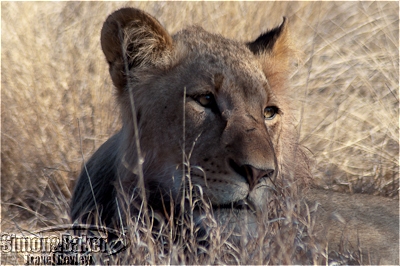
There was a large resident pride in Motswari
Beyond creating a welcoming haven for its guests, I also valued Motswari for its ongoing commitment to nature conservation and responsible tourism, which has been the guiding principle of the Geiger Family since it acquired the property three decades ago. From the onset, the original owner, the late Paul Geiger, focused on wildlife conservation and environmental management, and on creating employment and growth opportunities for the local communities; thus practicing the key tenets of responsible tourism and sustainable development long before they were articulated by the international community.
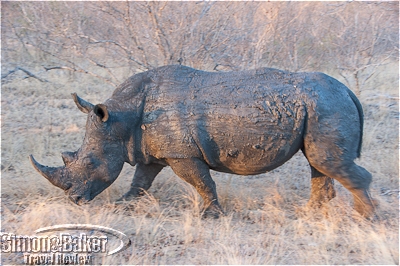
A rhino was caked with mud after a visit to a water hole
In recent years, Motswari has been repeatedly recognized for its achievements in that arena, such as its ongoing accreditation by the prominent Fair Trade in Tourism, South Africa (FTTSA), a distinction the property first earned in 2008. In early 2013, Motswari also achieved Gold Class status on the Heritage Environmental Certification Program (based on internationally recognized sustainability and responsible business initiatives), making it the only environmentally certified lodge in Timbavati. I especially appreciated the property’s concern for its people. Over and again its policies set the stage for responsible tourism. There appeared to be no gender discrimination for any position. Individuality and initiative were encouraged and acknowledged with a wide range of recognitions from Employee of the Year to Most Valuable and Most Popular and Best Dressed (staff members were given the opportunity to design their own uniform).
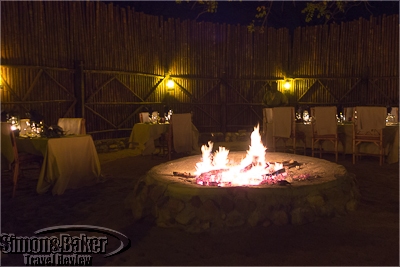
Dinner was served in the boma
Because the property was located deep into the reserve, it was necessary for all staff members to live on site. The family friendly staff village included accommodations for visiting spouses. I enjoyed hearing about some of the success stories, such as that of Godfrey Mathebula who grew up on the property and started out in the maintenance workshop. When he became interested in tracking and guiding, Paul Geiger sponsored his education. Mathebula went from guide to head guide to assistant general manager. In 2012, he was nominated for South Africa Guide of the Year.
Motswari also reached out to the community at large. As well as supporting local (Hoespruit) organizations with donations, the property had designated staff members to work with these organizations on issues of basic healthcare, nutrition, HIV education and testing. I left with the impression that the property’s responsible tourism ethos created a tight knit community among the management and staff of Mostwari, and an all around friendly atmosphere that directly influenced the exceptional quality of my bush experience there.
by Editor | May 12, 2014 | Accomodations, Ecotourism, New Articles
Article and photos by Josette King
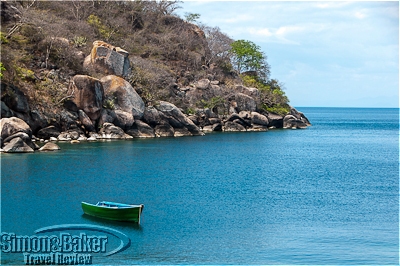
The view from my tent at Mumbo Island
When I first heard of Malawi, in the earliest days of my love affair with Africa over a decade ago, I confess that I had to consult an atlas to locate the small landlocked country wedged into the southern end of the East African Rift Valley. Less than 900 kilometers (560 miles) from north to south and barely 160 kilometers (100 miles) at its widest, Malawi was overshadowed by its much larger neighbors, Tanzania to the north, Zambia and Mozambique to the south, east and west. It was, and remains as of this writing, mainly unnoticed by international tourism travelers. Yet this narrow strip of rugged terrain carved by the Great Rift Valley is rich in spectacular vistas and home to several national parks, and of course Lake Malawi, known by the most passionate divers and water sports enthusiasts. It is the third largest of the African lakes, and for some arguably the most beautiful.
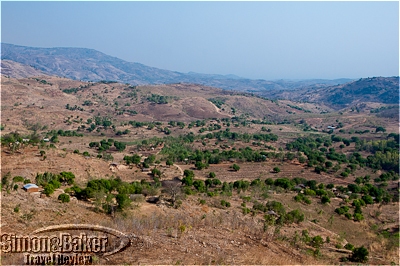
Great swaths of the country were used for subsistence agriculture
It is also one of the poorest countries in Africa, and one for whom the development of a viable tourism industry is an important growth and indeed survival factor. It was this opportunity to have it all, to visit, and through that support a country in the early stages of modern development as well as enjoy a safari off the beaten track, and experience a remote tropical beach environment known by many in the region, but rarely visited by international travelers, all within a few hours’ drive that made Malawi an irresistible destination for my most recent African visit.

The shores of Lake Malawi were dotted with fishing villages
Reaching Malawi had its challenges. With a population of 16 million living mainly in rural areas, and an economy largely based on subsistence agriculture, it is one the least developed countries in Africa, with only the most rudimentary national infrastructure. And what of the tourism infrastructure? I needn’t have worried. A few forward thinking properties have established themselves in recent years, ranging from unabashedly off the grid to luxury class, in the most desirable tourism destinations in the country. Each had a unique personality that was just right to ensure optimum enjoyment of it surroundings. One constant however, throughout my visit to the peaceful little country was the warm welcome of the gentle people of Malawi.

The king size bed at Mvuu faced the deck and the bush
From a luxury safari perspective, Malawi is for people who want a bit of real world authenticity with their posh African safari.
Mvuu Lodge in Liwonde National Park, considered the premier park in Malawi for its large population of hippos and elephants and its abundant bird life, offered intimate wilderness tented accommodations with a casual atmosphere and the creature comforts I have come to expect from a luxury safari property. Ideally located at the edge of a secluded lagoon across the Shire River from the park entrance, it could be reached only by boat. The open sided main area was raised high into the trees for a sweeping view of the constant wildlife activity along the lagoon. The riverside location allowed for a mix of cruises and drives that provided a close and varied view of the game as it went about its daily life. The highpoint of my stay was a perfect morning on the river, when we came across a bachelor herd of elephants, one of them sound asleep (yes, elephants can sleep laying down), then spent a memorable hour watching their antics as they horsed around in the middle of the river like teenagers at the beach.
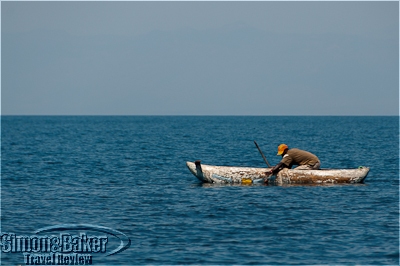
A local fisherman casting his net from a dugout canoe
Some 580 kilometer (360 mile) long, Lake Malawi is the main topographic icon of the country. It is internationally renowned among water sports enthusiasts and naturalists for its pristine shores and deserted islands nestled between towering boulders rising straight from crystal clear waters alive with small brightly colored fish. The beauty of the scenery and the hundreds of endemic species of cichlids fish drove the Malawi government to set aside the southern end the lake as Lake Malawi National Park in 1980. It was the first fresh water marine reserve in the world, and then in 1984 it became a UNESCO World Heritage Site.
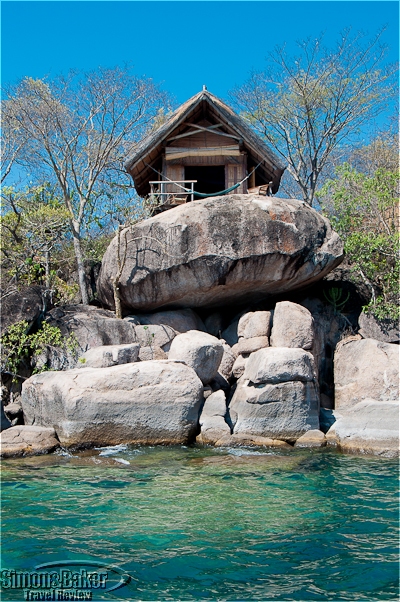
My tent was a reed and thatch bungalow high above the lake
An hour’s motorboat ride off shore from Cape Maclear, Mumbo Island was a pristine one square kilometer (250 acres) dot of granitic rock topped by lush miombo woodland and blessed with a crescent beach of golden sand. Until the National Parks authorities first awarded Kayak Africa the exclusive rights to operate tourism accommodations on the island in 1996, it had never been populated. To preserve its unspoiled beauty, Kayak Africa created Mumbo Island Camp, a minimalist property run on uncompromising sustainable principles. It consisted of rustic bungalows of reed and thatch with comfortable beds, bucket showers and “eco-loos,” perched high in the rocks to better admire the dazzling waters of the lake, a dining area that served wholesome, simple foods, and in a corner of the beach, a water sports gazebo. There was no electricity, just solar and paraffin lamps and wind up flashlights. What did I like best? The dawn wake up call of a red billed hornbill enthusiastically welcoming the sunrise, and snorkeling in warm waters so clear I could see the outlines of underwater boulders deep beneath me, bright cichlids darting about them, and kayak rides to watch the sun dip into the lake, and… well, everything. The ultimate luxury of Mumbo Island Camp was its very existence.
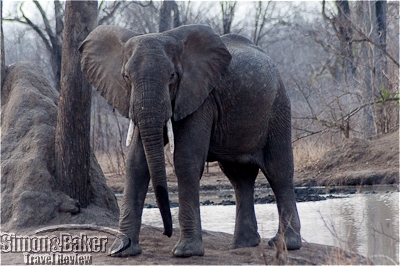
Elephants were a common sight at Mkulumadzi
Mkulumadzi, the sole property in Majete Game Reserve, the recently reborn only Big Five game park in Malawi on the Lower Shire River; and Pumulani, on the western side of the Nankumba Peninsula at the edge of the Lake Malawi National Park, were sister properties designed for Robin Pope Safaris by G. Hooft Graafland, a Dutch architect. These innovative world class luxury lodges sat gently upon the land, each guest accommodation custom designed to fit into the topographic elements of its environment, and covered with a roof of endemic vegetation to help offset its own carbon footprint and regulate inside temperatures.
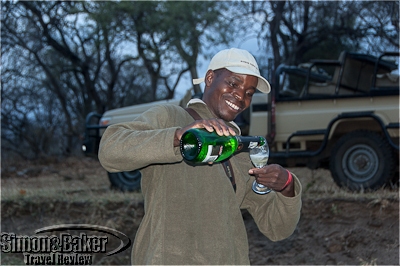
Samuel Chihana pours a sundowner drinks for us
While the properties had their distinct character best adapted to their purpose, both were decorated in an elegantly understated contemporary style that offered optimum comfort without ever distracting from their breathtaking surroundings. Each had its own trademark feature. At Mkulumadzi, the wilderness lodge, it was the impressively engineered 88 meter (290 foot) suspension foot bridge that led across the river to the property’s entrance. It never failed to deliver new game viewing opportunities and make me feel like an explorer of a bygone era.
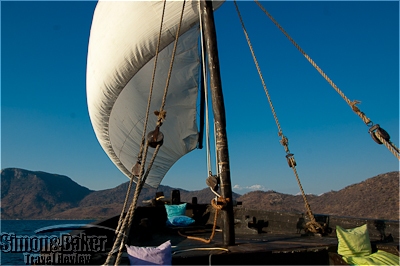
The traditional dhow sailed around the lake
At Pumulani, the lakeside beach lodge, the unique feature was the authentic, hand built wooden dhow with a triangular sail, reminiscent of the days when Arab traders plied the waters of the lake, always ready to take me on a breakfast or sunset cruise. And best of all, along with exceptional memories I took away the satisfaction to have experienced two properties in harmony with my responsible tourism ethos.
But that was no surprise. On one of my early visits to Zambia many years ago, I had the good fortune to meet Robin and Jo, the founders of Robin Pope Safaris. It was a conversation that went a long way to opening my mind to the power of responsible tourism as a tool for sustainable development in Africa and beyond.
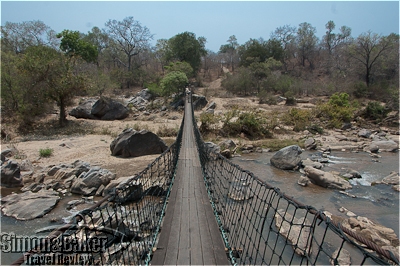
The lodge was reached via a suspension footbridge over the Mkulumadzi River
These two premier properties, relatively recently opened in a country still in the early stages of development were an ideal opportunity to experience first hand the contribution that the presence of my fellow tourists and I were making to the protection of previously at risk wilderness areas, while helping to alleviate poverty through good local employment practices, and the involvement of the local communities. I was delighted to hear that Pumulani was recognized as Malawi’s leading hotel at the 2011 and 2012 World Travel Awards.
by Editor | Mar 31, 2014 | Accomodations, Ecotourism
Photos by Josette King
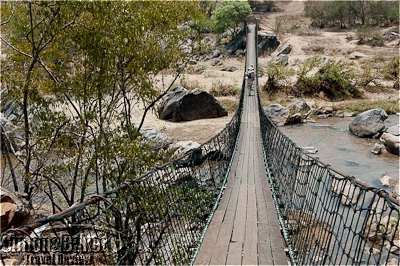
The lodge was reached via a suspension footbridge over the Mkulumadzi River
The recently restored Majete Wildlife Reserve in southern Malawi remains mostly undiscovered by tourists. Mkulumadzi offered accommodations within a 7,000 hectare (27 square mile) private concession with exclusive tourism rights in one the most spectacular areas of the repopulated wilderness area.
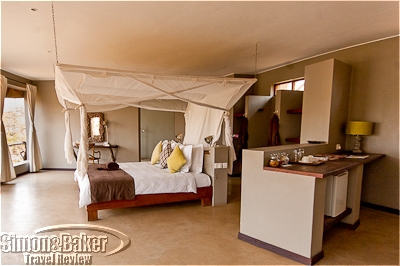
Josette’s room featured a well appointed pantry
Designed to minimize its impact on the environment while offering high levels of creature comforts, the property also focused on serving healthful, refined international dishes with a pan African accent. Beyond game viewing our contributor especially appreciated Mkulumadzi’s responsible tourism practices and guest centered service.
by Editor | Dec 9, 2013 | Attractions, Ecotourism, New Articles
Article and photos by Laura Scheiber
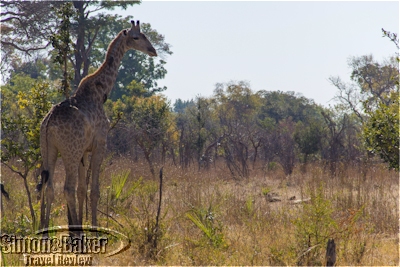
A giraffe keeping vultures away from her baby
For me, an ideal vacation includes a little rest and relaxation mixed in with adventurous activities. Perhaps this was why my stay at Tongabezi Lodge along the mighty Zambezi River in Zambia was so memorable. On the day of arrival at this luxury lodge, I met with Quentino Mbingi, the director of activities, who invited me to choose from a handful of activities ranging from the adrenaline pumping thrill of sitting on the edge of Victoria Falls to relaxing on a sunset boat cruise on the Zambezi River with sundowners. Quentino efficiently put together an itinerary that allowed me to partake in all of my preferred activities during my three day stay. Most activities were included in the room rate, along with meals, and drinks. Some activities offered by outside companies were available for an additional fee.
On my first day, I enjoyed a two hour sunset cruise on the beautiful Zambezi River. Four other guests and I hopped into a small motor boat on the dock at Tongabezi with Captain Victor, a soft-spoken friendly man who pointed out the many birds we observed along the bank. We meandered around a small island in the middle of the river, and Captain Victor positioned our boat within a few feet of crocodiles sunbathing on the sandbar. Without warning, one of the big crocodiles splashed in the water at lightening speed. I had quite the adrenaline rush. I would have felt scared if I hadn’t been in such good hands.
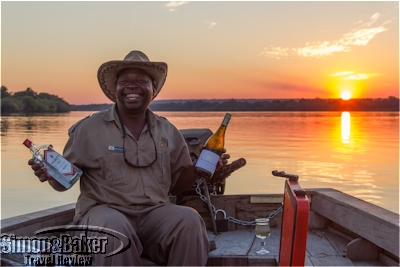
Captain Victor serving up sundowners
While stopping for sundowners in the middle of the river and watching the magnificent sunset, Captain Victor explained that he was a well-known crocodile hunter who had caught hundreds of crocodiles in his lifetime and set them free further down river away from human populations. I liked hearing his fascinating stories about crocodile (and snake) hunting while drinking a refreshing South African Sauvignon Blanc on the Zambezi River.

A crocodile sunbathing on the river bank
The next day I went on a private game drive in Mosi-Oa-Tunya National Park, the second smallest in all of Zambia, and roughly 20 minutes from Tongabezi. I had hoped to see a rhinoceros since it was the only one of the Big Five that I had not seen during previous safari adventures in Zambia. My private gaming guide, Fabias, provided clear and interesting explanations of the animals we saw while stopping anytime I wanted to take pictures. Most memorable was when Fabias spotted a number of vultures flying high in the sky. He drove to where they were circling and a few minutes later, he spotted a giraffe in the distance herding a bunch of vultures on the ground. Curious to find out what was going on, he drove closer to the giraffe where we eventually saw a young giraffe that had died sometime within the previous 24 hours, according to Fabias. Though sad, we couldn’t help but watch the mother giraffe valiantly try to keep the vultures away from her baby.
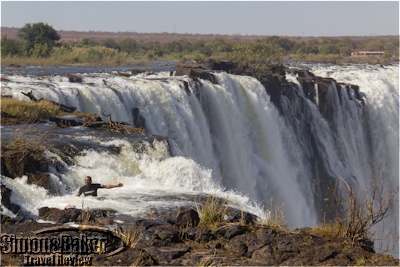
My guide demonstrated where I should sit at the edge of the falls
After a two-hour game drive, Fabias drove me to the five-star Royal Livingstone Hotel where the management of Tongabezi surprised me with a complimentary gourmet lunch and tour of Livingstone Island, which departed from the Royal Livingstone. I, along with seven other guests, was chauffeured by motorboat to the island where, our tour guide, Collins, took us on a five-minute walk to the side of the island facing Victoria Falls. He offered wetsuits to those of us interested in sitting in the natural pools in the Zambezi River on the edge of the Falls. Our fearless leader walked us toward the edge that had a heart-pounding drop of 100 meters. The views were spectacular and we were treated to a double rainbow. Collins carefully led three of us, one by one, into the water where we sat about 15 feet away from the edge of the Falls. Scary? Yes. Exhilarating and unforgettable? Absolutely. After such an adrenaline pumping experience, we were served a delicious lunch of fresh green salads, couscous, fresh tilapia fish, grilled vegetables, and a sweet bread pudding as a dessert. A South African white wine went well with the fish.
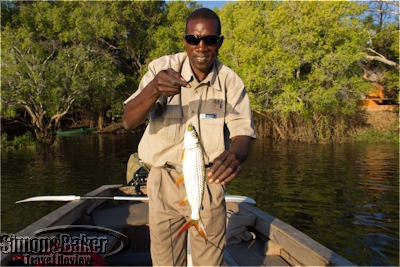
The tiger fish I caught with Fabias
After we returned to Tongabezi, Fabias prepared a small motorboat for my private fishing excursion. It was a lovely late afternoon with ideal temperatures and a cloudless sky, perfect for a relaxing boat ride on the Zambezi River. Fabias patiently showed me how to work the fishing rod and explained Tongabezi’s catch and release fishing policy. Within minutes, I felt a tug on my fishing line and excitedly reeled in a tiger fish. Fabias took care of the not so pleasant task of unhooking the fish. Throughout the trip, I enjoyed sundowners of my choice and opted for a refreshing South African Sauvignon Blanc. The hour and a half fishing trip ended with a beautiful sunset. At the end of a day full of activities, I was pleasantly surprised to find a bottle of sparkling wine in a bucket of ice, and a candlelit hot bubble bath waiting for me in my room, compliments of Tongabezi.
My final river adventure was a private canoe trip. Quentino, a certified river guide, went over the safety rules and helped me into a small canoe, while Captain Victor was in a motorboat ahead looking out for crocodiles and hippos. Quentino welcomed me to paddle, but made it clear that it was not necessary if I preferred to relax and take in the tranquil scenery. After crossing the river towards the Zimbabwe side, Quentino pointed out a number of colorful birds that were fishing along the riverbank. On our way back to Tongabezi, we canoed through some reed-covered islands where hippos were resting on sandbanks about 50 feet away from us. It was exciting to be so close, but I was happy to keep a distance, as I knew how fast hippos could move. Between Captain Victor and Quentino I felt in good hands, as both had had years of training and experience as river guides.
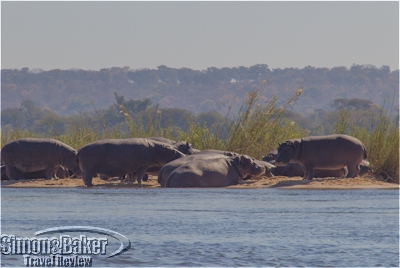
Hippos sunbathing during my canoe trip
The only downside of my stay at Tongabezi Lodge was that it ended too soon. The location of this luxury lodge was ideal. Just 40 minutes upstream from the hustle and bustle of Victoria Falls, the lodge was close enough for activities associated with the UNESCO world heritage site, while far enough to explore the Zambezi River. Having an activities director who customized my itinerary added a personal touch that set Tongabezi apart from other lodges. The service was top notch and I plan on returning someday to partake in the activities I did not include during this first visit.
by Editor | Dec 2, 2013 | Attractions, Ecotourism, Luxury Travel
Article and photos by Laura Scheiber

A double rainbow over Victoria Falls
During a trip to Zambia, I visited Victoria Falls, a UNESCO world heritage site forming part of the border of Zambia and Zimbabwe. Powered by the mighty Zambezi River, the falls are over 1,700 meters in width, and an impressive 100 meter drop. The Falls are known in the local language as Mosi-oa-Tunya meaning The Smoke that Thunders. I was in awe at the spray that loomed above this geographic wonder that has bragging rights to the greatest sheet of falling water in the world. One of the Seven Natural Wonders of the World, I anticipated it to be beautiful, but Victoria Falls was beyond my expectations in terms of size, strength and magnificence.
To get to Victoria Falls, I took a one hour flight from Lusaka to Livingstone within Zambia. I stayed at Stanley Safari Lodge, a luxury lodge tucked away on a hillside in the African bush, just a ten minute drive from the falls.
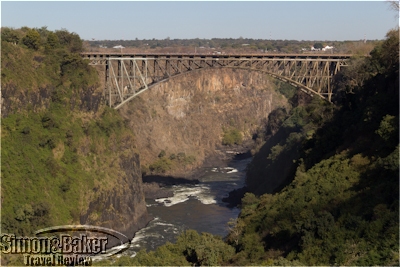
The bridge connecting Zambia and Zimbabwe
To enter Victoria Falls, I had to register at an entry point. International guests at the time of my visit in June 2013 had to pay a fee of $20. Luckily for me, the staff at my lodge arranged day and night walking tours with a private guide, Effeso Hammabola, who helped me navigate through the entry process.
Since I happened to be visiting during a full moon, I had the opportunity to do an evening Luna Tour. The highlight was seeing a rainbow at night, illuminated by the moon above the falls. We stopped at four different viewing points along the man made walkway on the edge of the falls during the hour long tour. I was amazed at how close we could get to the bank of the river just before it spilled over the edge.
Though I enjoyed the evening tour, I much preferred my day visit when I could fully appreciate the beauty and impressive size of the falls.

Effeso Hammabola, my Victoria Falls guide
Thanks to the proximity of my accommodations I was the first guest to arrive and finished up my two hour tour before hoards of tourists entered the site. Starting at the bank of the river, Effeso and I followed the walkway that had numerous lookout points from different angles, including the side of the falls, directly facing the falls and views of the Zimbabwe side where we could see a series of gorges. It was a pleasant pathway with many trees and greenery surrounding it.
I visited at the end of June, which was an ideal time because there was still an impressive amount of water in the Zambezi River that powered the falls yet the water flow wasn’t so strong that the amount of spray made it difficult to see, which happens, I was told, during the wet season.
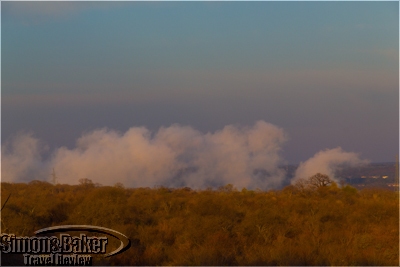
Spray from Victoria Falls
Overall my trip to the area was an unforgettable experience due to the awe inspiring size, incredible force and utter beauty of Victoria Falls. I would recommend a trip to friends and family who are interested in geographic wonders. I also would return to Stanley Safari Lodge to steer clear of the urban hustle and bustle of Livingstone while remaining close enough to the falls in the early morning hours.












































